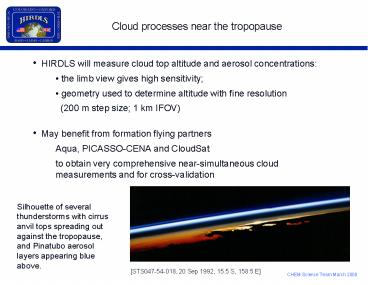Cloud processes near the tropopause - PowerPoint PPT Presentation
1 / 14
Title:
Cloud processes near the tropopause
Description:
HIRDLS will measure cloud top altitude and aerosol concentrations: ... and mixing in the upper troposphere/lowermost stratosphere/lower overworld ... – PowerPoint PPT presentation
Number of Views:22
Avg rating:3.0/5.0
Title: Cloud processes near the tropopause
1
.
Cloud processes near the tropopause
- HIRDLS will measure cloud top altitude and
aerosol concentrations - the limb view gives high sensitivity
- geometry used to determine altitude with fine
resolution - (200 m step size 1 km IFOV)
- May benefit from formation flying partners
- Aqua, PICASSO-CENA and CloudSat
- to obtain very comprehensive near-simultaneous
cloud measurements and for cross-validation
Silhouette of several thunderstorms with cirrus
anvil tops spreading out against the tropopause,
and Pinatubo aerosol layers appearing blue above.
STS047-54-018, 20 Sep 1992, 15.5 S, 158.5 E
2
Frequency of cirrus measured by HALOE
Relative frequency of occurrence of larger
extinction values measured at 3.46 micron by the
UARS HALOE instrument for 1993-1998. S.Massie
et al, submitted to J. Geophys. Res., 1999
3
Frequency of cirrus measured by HALOE
Relative frequency of occurrence of larger
extinction values measured at 3.46 micron by the
UARS HALOE instrument for 1993-1998. S.Massie
et al, submitted to J. Geophys. Res., 1999
4
Variation of limb extinction
Frequency of limb extinction at 3.46 micron and
121 hPa tangent pressure measured by HALOE for
different years. Data are for the Indian Ocean
to the Eastern Pacific between 30oN and 30oS.
S.Massie et al, The Effect of the 1997 El Nino
on the Distribution of Upper Tropospheric
Cirrus, submitted to J. Geophys. Res., 1999
5
Radiative transfer studies
HIRDLS will measure the radiation emitted in
multiple spectral passbands up to the
thermosphere Important for validating radiative
transfer theory and undertaking basic research
into radiative transfer
6
Radiative transfer studies
(Day-Night )/Night radiance difference measured
by CRISTA in 1490-1560 cm-1 spectral region
Daytime enhancement is due to a combination of
H2O non-LTE emission and tidal activity
increasing daytime temperature
Figure from David Edwards
7
Acquisition of atmospheric data in an extreme
state
- Stratospheric chlorine levels are expected to
peak during - the EOS-Chem mission.
- EOS-Chem data will be valuable for centuries
into the future as - tests of model behaviour in this extreme
high-chlorine state. - Changes in ozone levels as chlorine declines and
stratospheric - cooling accelerates will provide critical tests
of model behaviour - and their ability to predict.
8
Stratospheric Chlorine
Growth of stratospheric chlorine according to
various scenarios
(from Joe Waters)
9
HIRDLS Scientific Objectives
- Understand stratosphere-troposphere exchange of
radiatively and chemically active constituents
(including aerosols) down to small spatial scales - Understand chemical processing, transports and
mixing in the upper troposphere/lowermost
stratosphere/lower overworld - Understand budgets of quantities (momentum,
energy, heat and potential vorticity) in the
middle atmosphere that control stratosphere-tropos
phere exchange - Determine upper tropospheric composition (with
high vertical resolution) - Provide data to improve and validate small scales
in models - Measure global distributions of aerosols and
PSCs and interannual variations
10
Major HIRDLS Emphases
- Small scale dynamics and transports
- Troposphere - stratosphere exchange
- Polar vortex filamentation
- Tropical barrier leakage
- Upper troposphere - lower stratosphere chemistry
- O3, H2O, CFC11, CFC12, HNO3, CH4, N2O
- Aerosol amounts, distributions properties
- Trends changes
- Trends of 10 radiativity chemically active
species, T, PSCs - Continuation of LIMS, SAMS, UARS
- Gravity wave distributions
- Sources distributions of gravity waves, and
their roles in atmospheric dynamics
11
Summary of Measurement Requirements
- Temperature lt50 km 0.4 K precision
- 1 K absolute
- gt50 km 1 K precision
- 2 K absolute
- Constituents O3, H2O, CH4, H2O, HNO3, NO2, N2O5,
1-5 precision - ClONO2, CF2Cl2, CFCl3, Aerosol 5-10
absolute - Geopotential height gradient 20
metres/500 km (vertical/horizontal) - (Equivalent 60oN geostrophic wind)
(3 m s-1) - Coverage
- Horizontal - global 90oS to 90oN (must include
polar night) - Vertical - upper troposphere to mesopause
(8-80 km) - Temporal - long-term, continuous (5 years
unbroken) - Resolution
- Horizontal - profile spacing of 5o latitude x
5o longitude (approx 500 km)
12
HIRDLS Cleanroom
13
Collimator/monochromator calibration equipment
14
HIRDLS Calibration Facility
Chamber optical bench
Clean room and vacuum chamber
Seismic isolator
Monochromator turret































